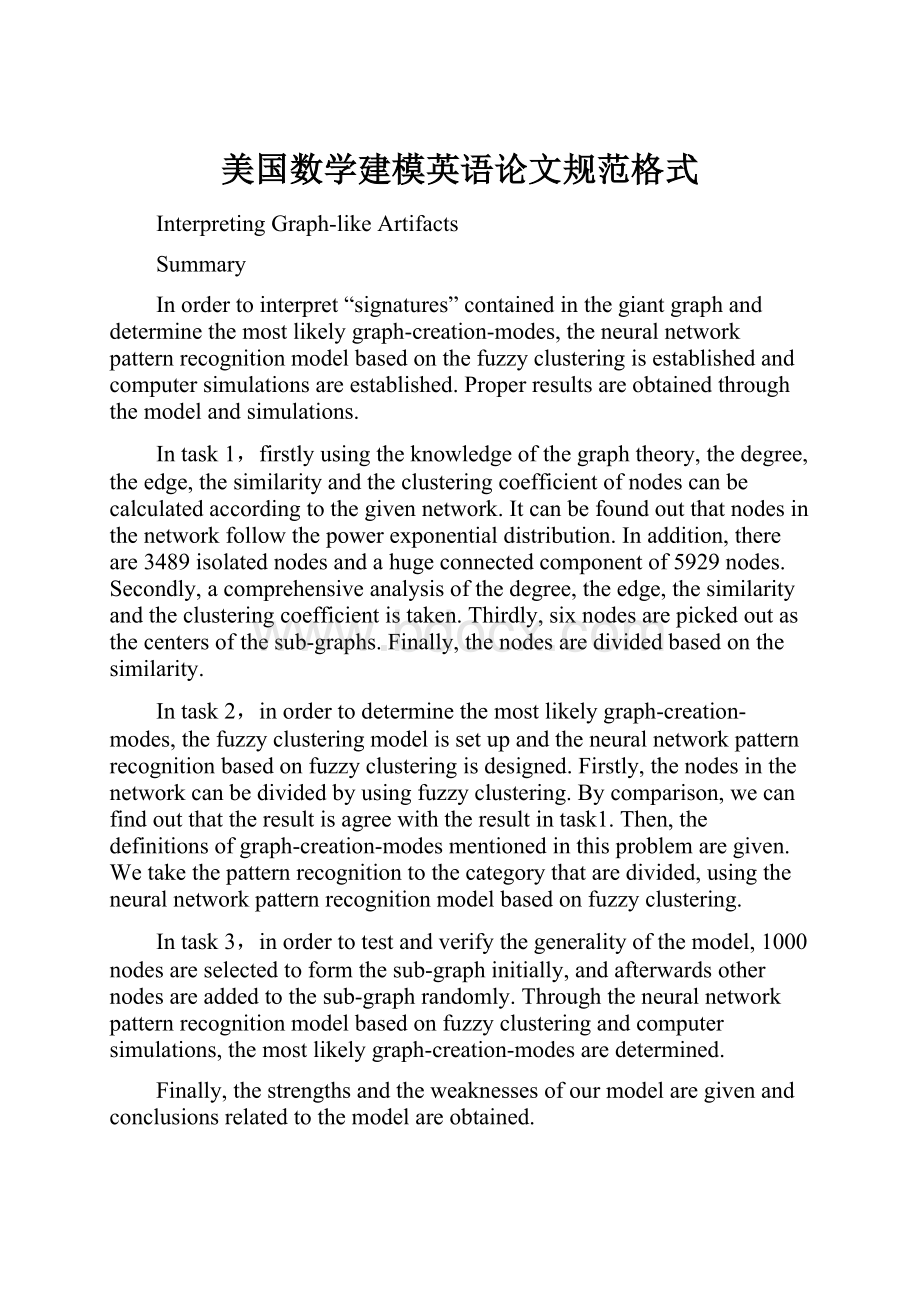美国数学建模英语论文规范格式.docx
《美国数学建模英语论文规范格式.docx》由会员分享,可在线阅读,更多相关《美国数学建模英语论文规范格式.docx(24页珍藏版)》请在冰豆网上搜索。

美国数学建模英语论文规范格式
InterpretingGraph-likeArtifacts
Summary
Inordertointerpret“signatures”containedinthegiantgraphanddeterminethemostlikelygraph-creation-modes,theneuralnetworkpatternrecognitionmodelbasedonthefuzzyclusteringisestablishedandcomputersimulationsareestablished.Properresultsareobtainedthroughthemodelandsimulations.
Intask1,firstlyusingtheknowledgeofthegraphtheory,thedegree,theedge,thesimilarityandtheclusteringcoefficientofnodescanbecalculatedaccordingtothegivennetwork.Itcanbefoundoutthatnodesinthenetworkfollowthepowerexponentialdistribution.Inaddition,thereare3489isolatednodesandahugeconnectedcomponentof5929nodes.Secondly,acomprehensiveanalysisofthedegree,theedge,thesimilarityandtheclusteringcoefficientistaken.Thirdly,sixnodesarepickedoutasthecentersofthesub-graphs.Finally,thenodesaredividedbasedonthesimilarity.
Intask2,inordertodeterminethemostlikelygraph-creation-modes,thefuzzyclusteringmodelissetupandtheneuralnetworkpatternrecognitionbasedonfuzzyclusteringisdesigned.Firstly,thenodesinthenetworkcanbedividedbyusingfuzzyclustering.Bycomparison,wecanfindoutthattheresultisagreewiththeresultintask1.Then,thedefinitionsofgraph-creation-modesmentionedinthisproblemaregiven.Wetakethepatternrecognitiontothecategorythataredivided,usingtheneuralnetworkpatternrecognitionmodelbasedonfuzzyclustering.
Intask3,inordertotestandverifythegeneralityofthemodel,1000nodesareselectedtoformthesub-graphinitially,andafterwardsothernodesareaddedtothesub-graphrandomly.Throughtheneuralnetworkpatternrecognitionmodelbasedonfuzzyclusteringandcomputersimulations,themostlikelygraph-creation-modesaredetermined.
Finally,thestrengthsandtheweaknessesofourmodelaregivenandconclusionsrelatedtothemodelareobtained.
Keywords:
theneuralnetworkpatternrecognitionmodel;thecomputersimulations;thegraphtheory;theclusteringcoefficient
1.Introduction
Inmanyfieldsofphysical,biologicalandsocialscienceswherethesizeanddynamicnatureofthedatasetssimilarlydonotallowforexactanswers,aniterativeinterplaybetweenexperimentaldataandmodelingisnecessary.However,boththedataandthemodelingoftenhavearandomorstatisticalbasis.Suchinterplayisinitsearlystagesforthestudyofseveralmassive,dynamicgraphssuchastheWorldWideWeb.Thedegreedistributionsofseveraldifferentmassivegraphsfollowapowerlaw.Inthispaperwesimulateandanalyzemanyrandomsub-graphevolutionwithpowerlawdegreedistributionstofindthemostlikelyruleofthelargegraph’creation-mode.
ResearchrelatedtoRandomGraphisdiscussed.Extensiveandprofoundprogresshasbeenmadeinthisareabymanywellknownexperts.Afteranalyzingtheirpapers,weproposeseveralnewideastoimprovetheirmodelssoastomakethesemodelssuitabletothisproblem.Somebasicassumptionsaremadebasedontheneedsofthisproblem.Goalsandapproachesofmodelsinthispaperarelisted.Severalgraph-creation-modesproposedinthisproblemaredefinedandillustratedintheformofpropertiesofgraph.Itcanbehelpfultojudgethecreation-modeofacertaingraph.
Firstly,weshoulddevelopmodelsanddeterminethe"signatures"(i.e.,thecollectionsofgraph-traits)correspondingtoasmanyoftheabove"graph-creation-modes".
Secondly,weshoulddesignalgorithm(s)todeterminethelikelycreation-modeofagivenGraph.
Thirdly,weshouldtestouralgorithmsonsimulatedgraphs(illustratingdifferentcreation-modes)andonsomelargegraphavailableontheWeb.
2.Backgrounds
Intherealworld,therearelotsoflargeentitysystemsintheformofNetworkstructure,suchasthesocialrelationshipsofinteraction,theliteraturecitedineachresearchandthecollaborationnetworkofauthors.Sincenetworksareratherlargeandtheinteractionamongentitiesiscomplicatedintherealworld,theirspecificformsareoftenhidden.
Earlierscientiststhoughtthattherelationshipamongtherealsystemelementscanbedescribedbysomerulegeometricfigures.Therefore,thestudyonnetworkcanbestartedbasedontherulegeometricfigures.Thisiscalledtherulenetworkstage.Attheendofthe1950s,complexlarge-scalenetworkwithnospecificdesignprincipleismainlyusedfortherandomgraphswhicharesimpleandeasytobeacceptedbymostpeople.Thisiscalledtherandomnetworkstage.Inrecentyears,withtherapiddevelopmentofthetechnologyincommunicationandelectronicinformationfields,scientistsfoundthatlotsofrealnetworksneitherbelongtotherulenetwork,northerandomnetwork.However,theyhavestatisticalpropertiesincommonwhicharesignificantlydifferentfromtheabovetwo.Theyhaverathercomplexityinscale,structureandfactors.Thus,thisiscalledthecomplexnetwork.
3.Assumptions
(1)Therearenomorethantwoedgesbetweentwonodes.
(2)Theconnectivityofsomenodesexistsbecausethesenodescontainthesameorsimilarinformation.
(3)Thegraph-creation-modescanbereflectedthroughthegrowthofnodesandedges.
(4)Thegraph-creation-modeofanysub-graphinalargegraphisthesame,andalsothesametothelargegraph.
(5)Astoasub-graph,thegreateritstotaldegreeis,thelargerthisgraphis.
(6)Allconnectedsub-graphsareregardedasconnectedcomponents.
4.Symbols
(1)
:
the
node;
(2)
:
theedgebetweenthe
nodeandthe
node;
(3)
:
theclusteringcoefficientofthe
node;
(4)
:
thedegreeofthe
node;
(5)
:
thesimilarityofthe
nodewithrespecttothe
node.
5.Modelestablishmentsandsolutions
5.1Task1
5.1.1Thedegreeofnodes
Thefollowingformulaisusedtodescribeagraph
.
Amongthem,eachelementof
istheundirectedpairofverticesin
knownastheedgesof
.Twoverticesineachpairmustbedifferent.Thus,thedescriptionofthegraphis
.
Inthegraph
thedegreeofthenode
istheadjacentnodenumberofthenode
.Ifthedegreeofanodeis0,thenthisnodeiscalledtheisolatednode.
Inordertoworkoutthedegreeofthenode,theadjacencymatrix
mustbefound.Itis
.
Thus,theadjacencymatrix
canbeexpressedasfollows
.
Furthermore,theexpressionofthenodedegreeisobtainedby
.
(1)
Basedonformula
(1),thedegreesofallnodescanbecalculated.Thenstatisticalanalysistothedegreesofallnodes(seeAppendix)isworkedoutandexpressedbythefollowingfigure.
Note:
Y-coordinateistakenaslog10.
Figure1Therelationshipbetweenthedegreeandthenumberofnodes
FromFigure1,weknowthatifthedegreeofnodesbecomesgreater,thenumberofnodesbecomessmallerandthenumberofnodesdecreasesexponentiallyapproximatelyasthedegreeincreases.Inaddition,thetotalsumofallnodedegreesis31938,andtheaveragedegreeis3.3.Ofallnodesinthegivengraph,about3500nodesareisolated.Mostofthenodeshaveadegreewhichisbelow50.
Thenodeswhosedegreeisrankingfrom1to20areselected(SeeTable1).
Table1Thenodeswhosedegreeisrankingfrom1to20
Ranking
Degree
Num
Ranking
Degree
Num
1
199
1806
11
87
7755
2
172
1079
12
85
82
3
168
235
13
85
4823
4
155
9
14
82
8671
5
139
0
15
80
8652
6
134
2078
16
78
1812
7
131
14
17
78
3020
8
109
6427
18
77
70
9
100
31
19
76
257
10
95
8687
20
76
1617
5.1.2Theclusteringcoefficientofnodes
Ingeneral,weassumethatnode
connectswiththeothersby
edges.Thus,thecorresponding
nodesaretheneighboursofthenode
.Furthermore,thereare
edgesatmostbetweenthe
nodes.Theratiooftheedgesbetweenthe
nodestothetotal
iscalledtheclusteringcoefficientofthenodes
.Namely,itis
.
(2)
Theclusteringcoefficientoftheentiregraph
isthemeanofallthenodes
.Thus,therangeoftheclusteringcoefficientis
.
representsthatallthenodesareisolated.
representsthatthecorrespondingnetworkisglobalcouplingwhichmeansthatanytwopointsaredirectlyconnectedinthegraph.
Themeanclusteringcoefficient
isobtainedbyrunningMatlab.Thus,themeancouplingofallthenodesis0.0504.
5.1.3Theedgeofnodesandthescoreoftheedges
Itcanbefoundinthedatathatfewnodesareconnectedwiththesamenodebytwoedges.Thus,wethinkthatitmaybemoresuitablethanthedegreediscussedabovebyintroducingtheconceptoftheedge.
Anodemayconnectwithseveralnodesdirectlyandscores1timeasthenumberoftheedgesbetweenthem;thesenodesmayalsoconnectwithmanyothernodesdirectlyandscores1/2timeasthenumberoftheedgesbetweenthem;thesenodeswhichweobtainrecentlymayalsoconnectwithmanyothernodesdirectlyandscores1/3timeasthenumberoftheedgesbetweenthem…theyarerespectivelycalledthefirstprocesscorrespondingtothefirstedgescore,thesecondprocesscorrespondingtothesecondedgescoreandthethirdprocesscorrespondingtothethirdedgescore…(SeeTables2,3and4).
Table2Thenodeswhosefirstedgescoreisrankingfrom1to20
Ranking
Score1
Num
Ranking
Score1
Num
1
199
1806
11
90
4823
2
172
1079
12
89
7755
3
168
235
13
85
82
4
155
9
14
82
8671
5
143
0
15
80
8652
6
134
2078
16
79
257
7
132
14
17
78
1812
8
109
6427
18
78
3020
9
100
31
19
77
70
10
95
8687
20
76
1617
Table3Thenodeswhosesecondedgescoreisrankingfrom1to20
Ranking
Score2
Num
Ranking
Score2
Num
1
1217
1080
11
705.5
2125
2
1212
236
12
704.5
834
3
903.